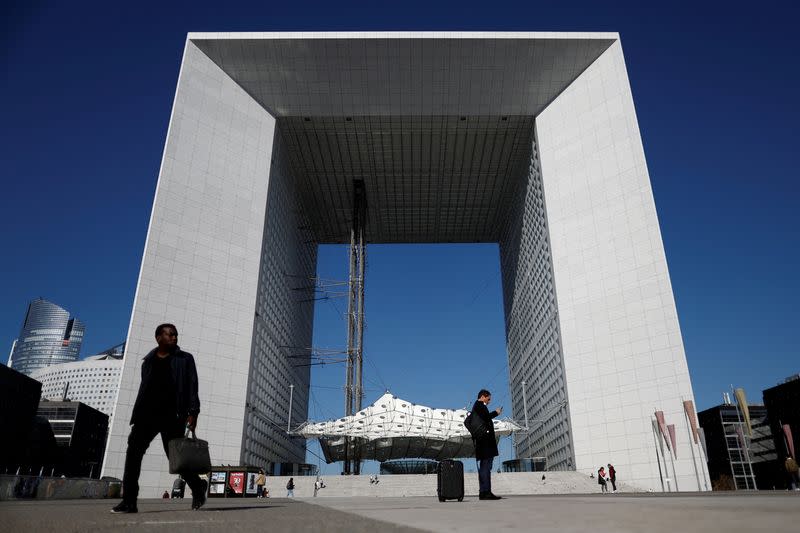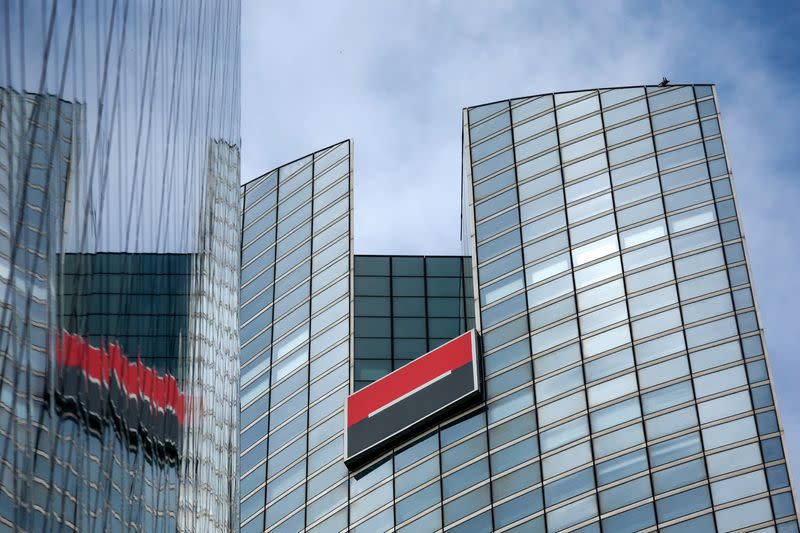Paris' La Defense seeks revival with smaller, greener offices
By Mathieu Rosemain
PARIS (Reuters) - Paris's La Defense business district is betting that modernising more than 300,000 square metres (3.2 million sq. ft) of offices into greener and more flexible work space will lure back companies and ease record high vacancy rates.
With brutalist architecture and modern skyscrapers dominating the skyline to the west of the Arc de Triomphe, La Defense is considered Europe's largest purpose-built business district. As in commercial city areas elsewhere, offices emptied during the pandemic and deals collapsed. The vacancy rate jumped above 15% from less than 10% pre-pandemic, far higher than the 2% vacancy rate in central Paris, according to property agents.
Many of its towers are dated and environmentally unfriendly, but it would be too expensive to demolish or convert most of them for other uses.
The head of Paris La Defense, the public body that runs the area, told Reuters the plan was to renovate in the next few years for tenants wanting less, but greener, space. The plan will start with 300,000 sqm, almost a tenth of La Defense's entire footprint.
One selling point is that average rents of about 550 euros ($588.61) per sqm are half those in supply-squeezed central Paris, agents estimate. Before the pandemic, central districts were about 40% more expensive than La Defense.
There are tentative signs of improving demand. Vacancy rates slipped from a record of nearly 16% last year to 15% in early 2024.
French IT services company Sopra Steria has moved into eco-friendly offices in a 1970s building that was reconfigured two years ago. It now boasts a Parisian-style restaurant-filled interior street.
"If you want to attract the best talent, you have to have very modern, very functional premises that facilitate teamwork,” Sopra Steria's Chief Executive Cyril Malarge told Reuters. "You want to make sure [people] want to stay in the office as long as possible."
It will not be easy to fill cavernous offices.
Aymeric Le Roux, an executive at property agent Savills, said newer buildings remain easier to rent than older sites, citing the rapid leasing of Unibail-Rodamco-Westfield's (URW) Trinity tower.
Some big projects have been axed. URW said in February it was pausing the planned twin towers "Sisters" project.
France's upcoming snap election could further rattle confidence if it produces a eurosceptic, far-right government.
"There are fewer big corporates taking on leases," Savills' Le Roux said.
"But it's not as bad as it looks," he added, with today's tenants wanting cutting-edge buildings that "the stock in [central] Paris is not offering" at scale.
URBAN PARK
The concept of La Defense, today home to CAC 40 companies including Vinci and Societe Generale, dates to the 1950s when plans were drawn up for a business district to replace run-down housing and small factories in the area. The first skyscraper topped out in 1966. The metro, shopping centres and the vast office complex of Coeur Defense followed.
Supporters say La Defence has weathered previous downturns and can do it again.
Paris La Defense now selects property projects on their energy and environmental credentials and is turning the main concrete public esplanade into a five-hectare urban park to be opened in 2027.
Lower-carbon and some renewable energy is used to meet part of the local power needs, and building management systems automatically switch office lights out at night and maintain temperature control.
"We're starting from a neighbourhood model that is extremely energy-intensive, extremely monofunctional," Paris La Defense CEO Pierre-Yves Guice told Reuters from his office overlooking the area.
"Despite what people may say, our ideas are still very rational, very adaptable to the needs of companies, and we can accommodate both large and small companies," he said.
That gives it an edge over central Paris where buildings are smaller, many of them from the 19-century and built of brick, limiting the use of more energy-efficient building materials.
La Defense will soon house France's tallest skyscraper, the 242-metre tall The Link, which opens next year to house long-time La Defense resident TotalEnergies.
The cost of renovating 300,000 sqm of offices to modern-day green standards will reach hundreds of millions of euros, experts estimate, shouldered mostly by big developers such as URW and Vinci.
To attract younger workers and companies, developers are building more apartments and transforming some older buildings into student housing or trendy hotels.
That resembles efforts in other cities hit by a downturn like London's Canary Wharf.
The challenge for La Defense now will be catering to smaller firms and the big companies wanting less space. Luxury groups Kering and LVMH's Christian Dior, for example, recently shifted parts of their back offices there.
Typical buildings in La Defense have been occupied by one or two companies but that could rise to 10 to 15, said real estate agency JLL France's Yannis De Francesco.
"It's a completely different way of marketing from the one we used to have and, incidentally, it takes a little longer, because you have more contracts to sign," he added.
($1 = 0.9344 euros)
(Reporting by Mathieu Rosemain; Editing by Tommy Reggiori Wilkes, Susan Fenton and David Gregorio)

 Yahoo Finance
Yahoo Finance 

